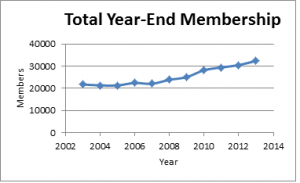Henry Louie – IEEE VP of Membership & Image
 In my role as PES Vice President of Membership & Image, I closely track our Society’s membership numbers and statistics. Looking back over just the last five years, I am truly amazed at PES’s growth, vibrancy and diversity. In this article, I share with you some of the facts and figures related to our membership. I also highlight a few of the new benefits PES is offering to members in 2014.
In my role as PES Vice President of Membership & Image, I closely track our Society’s membership numbers and statistics. Looking back over just the last five years, I am truly amazed at PES’s growth, vibrancy and diversity. In this article, I share with you some of the facts and figures related to our membership. I also highlight a few of the new benefits PES is offering to members in 2014.
Overall Membership Trends
PES ended 2013 with 32,300 members—another all-time high—which firmly secures PES’ place as the third largest society within the IEEE. Only Computer Society and Communications Society have more members.
In the last 10 years, PES membership has increased by approximately 50 percent, with the most rapid growth starting in 2008 and continuing through the present (see Figure). In retrospect, 2008 was a landmark year for PES—it was the year we renamed and re-branded ourselves the as Power & Energy Society, interest and investment in renewable energy and the Smart Grid invited more players into our field, and PES benefitted from strong leadership. We expect our growth to continue, while maintaining high retention rates.
Geographic Distribution of Membership
The IEEE internally partitions itself into 10 geographic areas called “Regions”. About 62 percent of PES members are from Regions 1- 7 (North America); 15 percent are from Region 8 (Europe and Africa), 8 percent are from Region 9 (South America); and 14 percent from Region 10 (Asia and Oceania).
Although the majority of our members reside in North America, the last several years have seen the strongest growth coming from Asia and Europe/Africa. The assertion that PES is a North American organization is quickly becoming antiquated.
Student Membership
One of the largest segments of our membership is our student members. Students make up approximately 15 percent (2,500) of our membership, which is nearly evenly divided between graduate student and undergraduate student members. Growth in student membership has been strong for PES, increasing by over 10 percent from 2012 to 2013, in part sustained by our First Year Free Program, which offers free membership in PES to students for their first year.
Looking more closely at the data show that student membership is strongest outside the U.S.—there are more student members in Asia and South America than in the U.S.
Diversity
PES has committed to increasing the diversity of its membership as it grows. While our geographic diversity is improving, we need to make improvements in age and gender diversification. PES is working to grow its share of the so-called Young Professional demographic—those within 10 years of their first engineering degree. Young Professionals in PES has increased from 12 percent in 2011 to 15 percent today. As with most IEEE Societies and engineering in general, females are underrepresented in PES. Obtaining complete gender information for our membership is challenging since many members never provide this information. However, based on the data we do have, PES female membership is likely between 5 and 8 percent. Despite these lower numbers, women have played a pivotal role in shaping our Society—two of the past three PES presidents are women! PES has aggressively sought to improve female membership, in part through our Women in Power Committee.
New Benefits in 2014
As we enjoy our membership growth, we also look for opportunities to better serve our members, and how we can attract more. I’d like to highlight two benefits that PES recently introduced.
The newly-launched Resource Center is an online repository of videos, presentations and technical and educational documents. Think of it as on-line shopping, but even better, because all the content is FREE to PES members. There are already close to 1000 items available, and more are being added each week.
The second new benefit is the Member-Driven Initiatives. This program awards funds to PES members to implement a program related to the PES mission. It could be developing an outreach program to primary school students, hosting a workshop for practicing engineers or even humanitarian activities. There is US$70,000 available for 2014. If you or your chapter has a project, I encourage you to apply.
Encourage a Friend or Colleague to Join PES
Lastly, our surveys have shown that most people join PES because someone—perhaps a professor, mentor or co-worker—encouraged them to do so. So, please consider “paying it forward” and recommending PES membership to a colleague, friend or student. Between now and August 15th, we have a promotion for new members—they can join PES for half price.
Henry Louie
IEEE VP of Membership & Image

